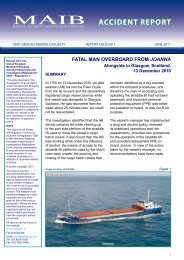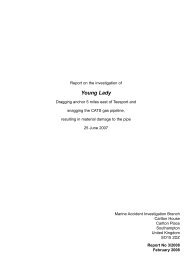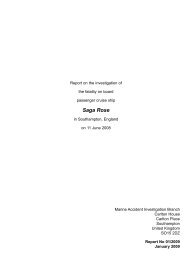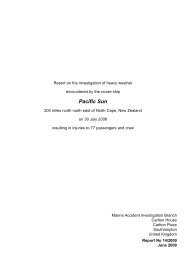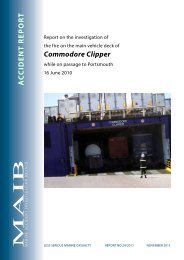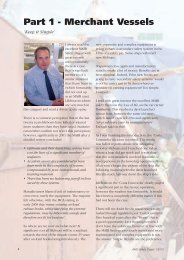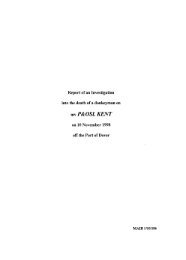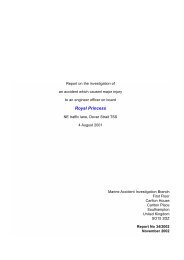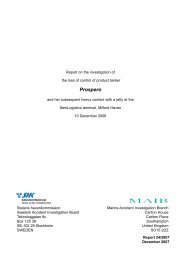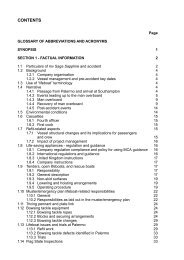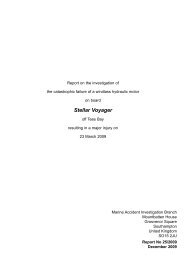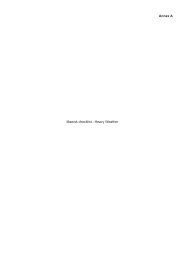Sichem Melbourne - Marine Accident Investigation Branch
Sichem Melbourne - Marine Accident Investigation Branch
Sichem Melbourne - Marine Accident Investigation Branch
You also want an ePaper? Increase the reach of your titles
YUMPU automatically turns print PDFs into web optimized ePapers that Google loves.
1.7.2<br />
1.7.3<br />
1.8<br />
16<br />
produce their own passage plan, provided it was kept for a period of at least 3 months<br />
after the pilotage “trip.” <strong>Sichem</strong> <strong>Melbourne</strong>’s pilot did not use the PLA house style<br />
Passage Plan document, but did use a plan of his own making.<br />
Pilot training<br />
All PLA pilots hold STCW Class 1 Master’s Certificates of Competency gained during<br />
statutory sea service. Upon employment with the Authority, pilots are given 6 months<br />
training, which includes shadowing experienced pilots and supervised ship, river and<br />
berth familiarisation. On completion of their training, pilots are assessed and examined<br />
before being authorised to operate un-chaperoned at designated levels of between<br />
Class 42 and Class 1, dependent on vessel length, and draught. When pilots wish to<br />
progress from a lower to a higher class, they are again supervised and assessed by<br />
a senior pilot. The PLA does not operate any system of regular pilot appraisal after<br />
they have gained authorisation to their class status, other than ship handling and<br />
manoeuvring on their in house bridge simulator.<br />
PLA acquired its own state of the art ship’s bridge simulator in 2003; it is housed in<br />
its Gravesend offices. The simulator was purchased to allow the Authority to train its<br />
pilots with realistic simulation of their own river, and replicates exactly, conditions of the<br />
River Thames. Simulation exercises are followed by peer review, however they do not<br />
include any form of Bridge Team Management (BTM) training or reference to master/<br />
pilot interaction.<br />
Coincidentally, PLA started training its pilots in BTM at an external training centre<br />
6 days after this accident. The training had been organised several months before<br />
the accident and involves sending groups comprising the same class of pilots to the<br />
training centre at the same time.<br />
Pilot<br />
The pilot had been employed by PLA for 10 years, during which time he progressed<br />
through the ranks from a Class 4 pilot to a Class 1, unrestricted sea pilot, in 2001. This<br />
qualification authorised him to carry out pilotage acts on any vessel plying between the<br />
Sunk pilotage and Crayfordness. After obtaining his Class 1 Masters certificate, he<br />
had sailed as chief officer on various ships, but never as master. Throughout his time<br />
at PLA the pilot had carried out 1240 acts of pilotage, with over 100 of those from the<br />
Coryton refinery jetties; he had not been involved in any previous accidents and was<br />
highly regarded by the PLA and colleagues.<br />
The pilot had attended a 5 day BTM training course at <strong>Marine</strong> International Safety,<br />
Rotterdam BV, 13 years previously, and had twice received 3 days ship handling<br />
training in the PLA ship’s bridge simulator. <strong>Sichem</strong> <strong>Melbourne</strong> was to be his first act of<br />
pilotage following 6 days of leave.<br />
PETROPLUS<br />
Petroplus is an independent refiner and wholesaler of petroleum products, operating 9<br />
sites within Europe. It took over the Coryton oil refinery and terminal from BP in June<br />
2007. For most of the staff, the takeover was simply a change of ownership, with the<br />
2 Class 4: up to 120m length or 6m draft; Class 3: up to 140m length or 7.5m draft; Class2: up to 160m<br />
length or 9m draft; Class 1: unrestricted length or draft.



